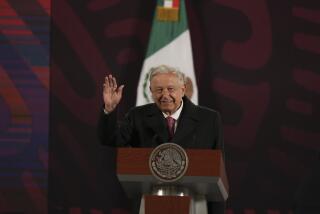A Fighter in the Mexican Revolution Recalls the Bloody Struggle
- Share via
While the consul general of Mexico was paying tribute last month in Los Angeles to the fallen heroes of the Mexican Revolution, an elderly man approached the microphone with the aid of a cane.
The audience almost stopped listening as their eyes shifted from the speaker to the white-haired, bronze-skinned man who paused beside a statue of Pancho Villa, the famed general who commanded the revolutionary forces in northern Mexico.
The small-framed man with the piercing brown eyes was Tomas D. Zepeda, the guest of honor. Zepeda, 88, of Huntington Park was not a well-known hero of the bloody revolution that began 75 years ago. But he was a participant, and he was a survivor.
“When I think of those days,” he told the audience, “I feel as though I am watching a movie. I see everything as if I was still there.”
It was on Nov. 20, 1910, that Francisco Madero called for armed insurrection against the dictatorship of Porfirio Diaz. With that call came a revolution that killed an estimated 1 million people, one-tenth of Mexico’s population. In an interview, Zepeda vividly described his first day in the revolution as a boy of 13 when he and two 14-year-old friends, the Pelafoz brothers, joined Pablo Gonzalez, a general whose forces were loyal to a future president of the republic, Venustiano Carranza.
“We were working at the Rancho de las Bolitas, in the state of Coahuila, when the general came by,” he said. “My two friends wanted to join. They asked me to join, so we joined together. On the very first day we battled the Federales, the government forces.”
Zepeda, who had been trying to avoid the Mexican army draft, signed up with the revolution. Except for the captains and generals, he said, every soldier in his regiment was under 16.
He recalled a battle at Hicamole in the state of Coahuila, in which the revolutionaries defeated Gen. Rosalio Hernandez.
“We defeated him and on the very same hill on which Don Porfirio Diaz had cried” in a battle against the French, “Gen. Hernandez also cried,” Zepeda said.
Carranza’s forces, Zepeda said, fought a number of battles against Villa--who had earlier broken ranks with Carranza--until the armistice in 1914 in Jimenez, Chihuahua.
When the armistice was agreed to, Villa’s and Carranza’s men spent three days together in Jimenez and got along like brothers, as if they had never been fighting against each other, Zepeda said. It was there, he said, where he met Villa, commenting that he believed he was a good man.
At that time, Villa was nursing a wounded leg, and American soldiers led by U.S. Army Gen. John J. Pershing came into Mexico hunting the famed fighter after Villa’s raid on Columbus, N.M. But Pershing found neither Villa nor his men.
Everyone, Zepeda recalled, hated the U. S. soldiers. He said he heard stories that the tortilleras, the women who made tortillas, had even killed a few American soldiers.
Zepeda said proudly that he fought in the revolution for three years and eight months. He recalled how he was almost killed in battle: “I had just dismounted when a cannonball struck my horse, right below the saddle. The cannonball broke my horse’s spine,” killing his mount instantly.
As in all wars, Zepeda saw the loss of many men, including many of his friends. His stepfather, who had joined the revolution the same year as he, was killed in battle in Guadalajara, the same battle in which a future president, Alvaro Obregon, lost an arm.
Zepeda said that, after leaving Carranza’s forces, he returned to Monterrey in northern Mexico with his family and moved on to Nuevo Laredo, Tex., in 1919. After a short stay there he settled in San Antonio, where he lived and worked as a painter for 35 years.
In 1954, he moved to Los Angeles, where one of his sons had settled, and has lived in the area ever since. He has been widowed four times and has only one surviving son. Zepeda had six children, all by his first wife.
He has not been back to Mexico in 50 years, but still prefers to speak in Spanish, even though he is bilingual. Zepeda said he regrets not writing about all the things he did and saw because, he repeated, “everything seems like a movie.”
Zepeda said he hopes to live to be 100. And there is a good chance that he may reach his goal, since his mother, Juanita Bustamante, lived to be 102.
More to Read
Sign up for Essential California
The most important California stories and recommendations in your inbox every morning.
You may occasionally receive promotional content from the Los Angeles Times.










